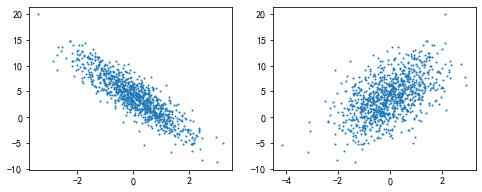1 导入实验所需要的包
import torch
import numpy as np
import matplotlib.pyplot as plt
from torch import nn
from IPython import display
#解决内核挂掉
import os
os.environ["KMP_DUPLICATE_LIB_OK"] = "TRUE"
2 生成数据集
将根据带有噪声的线性模型构造一个人造数据集。任务是使用这个有限样本的数据集来恢复这个模型的参数。这里使用低维数据,这样可以很容易地将其可视化。
在下面的代码中, 将生成一个包含 1000 个样本的数据集,每个样本包含从标准正态分布中采样的 2 个特征。合成数据集是一个矩阵 $mathbf{X} in mathbb{R}^{1000 imes 2} $ 。
使用线性模型参数 $ mathbf{w}=[2,-3.4]^{ op}$ 、 $b=4.2$ 和噪声项 $epsilon$ 生成数据集及其标签:
$mathbf{y}=mathbf{X} mathbf{w}+b+epsilon$
可以将 $epsilon$ 视为捕获特征和标签时的潜在观测误差。在这里认为标准假设成立,即 $epsilon $ 服从均值为 $0$ 的正态分布。为了简化问题, 我们将标准差设 为 $0.01 $ 。下面的代码生成合成数据集。
def get_random_data(w,b,num_example):
X = torch.normal(0,1,(num_example,len(w)))
#X = torch.normal(0,1,(num_example,2))
Y = torch.matmul(X,w)+b #矩阵乘法,要求稍微低一点
Y += torch.normal(0,0.01,Y.shape)
return X,Y.reshape(-1,1)
true_w = torch.tensor([2, -3.4])
true_b = 4.2
features, labels = get_random_data(true_w, true_b, 1000)
torch.mm(mat1, mat2, out=None) → Tensor
torch.matmul(mat1, mat2, out=None) → Tensor
对矩阵mat1和mat2进行相乘。 如果mat1 是一个n×m张量,mat2 是一个 m×p 张量,将会输出一个 n×p 张量out。
参数 :
mat1 (Tensor) – 第一个相乘矩阵
mat2 (Tensor) – 第二个相乘矩阵
features.shape, labels.shape
(torch.Size([1000, 2]), torch.Size([1000, 1]))
3 可视化初始数据
# 设置图的尺寸
plt.rcParams['figure.figsize'] = (8,3)
plt.subplot(1,2,1) #要生成两行两列,这是第一个图plt.subplot('行','列','编号')
plt.scatter(features[:,1].detach().numpy(), labels.detach().numpy(),s=1);
plt.subplot(1,2,2)
plt.scatter(features[:,0].detach().numpy(), labels.detach().numpy(),s=1);

labels.detach().numpy().shape
(1000, 1)
features[:,1].detach().numpy().shape
(1000,)
4 读取数据集
在下面的代码中,我们定义一个 data_iter 函数, 该函数接收批量大小、特征矩阵和标签向量作为输入,生成大小为 batch_size 的小批量。每个小批量包含一组特征和标签。
def data_iter(batch_size,features,labels):
num_example = len(features)
indices = list(range(num_example))
np.random.shuffle(indices)
for i in range(0, num_example, batch_size):
batch_indices = torch.tensor(indices[i: min(i + batch_size, num_example)])
# print("batch_indices=",batch_indices)
yield features[batch_indices], labels[batch_indices]
#采用yield 循环并没有结束,而是暂时”停止“,返回的是一个迭代器
# next(data_iter(50,features,labels))
# next(data_iter(50,features,labels))
测试一下:读取第一个小批量数据样本并打印。每个批量的特征维度说明了批量大小和输入特征数。 同样的,批量的标签形状与batch_size相等。
batch_size = 10
for X, y in data_iter(batch_size, features, labels):
print("features=",X, '
labels=', y)
break
features= tensor([[-1.3117, 0.0544],
[-2.1899, -0.9396],
[ 0.2574, 0.5958],
[-0.1184, 0.9712],
[ 1.2400, 0.7710],
[ 1.2233, 0.3990],
[-1.3850, -0.8254],
[-3.0746, 0.2081],
[ 0.3196, -0.3576],
[-1.8893, -0.6696]])
labels= tensor([[ 1.3906],
[ 3.0155],
[ 2.6977],
[ 0.6439],
[ 4.0464],
[ 5.2818],
[ 4.2274],
[-2.6520],
[ 6.0649],
[ 2.6800]])
5 初始化模型参数
w = torch.normal(0,0.01,size=(2,1),requires_grad=True)
b = torch.zeros(1,requires_grad=True)
6 定义模型
需计算输入特征 $X$ 和模型权重 $w$ 的矩阵向量乘法后加上偏置 $b $。需要注意的是当我们用一个向量加一个标量时,标量会被加到向量的每个分量上。
def linear(X,w,b):
return (torch.matmul(X,w)+b).reshape(-1,1)
7 定义损失函数
def MSE_loss(y_hat,y):
return ((y_hat- y )**2)/2
8 定义优化算法
def mini_batch_sgd(params,lr,batch_size):
"""小批量随机梯度下降。"""
#torch.no_grad() 是一个上下文管理器,被该语句 wrap 起来的部分将不会track 梯度。
with torch.no_grad():
for param in params:
param -= lr * param.grad / batch_size
param.grad.zero_() #梯度清零
9 训练
lr = 0.003
num_epoch = 20
net = linear
loss = MSE_loss
for epoch in range(num_epoch):
for X , y in data_iter(batch_size, features, labels):
y_hat = net(X,w,b)
cur_loss = loss(y_hat,y)
# print("cur_loss = ",cur_loss)
cur_loss.sum().backward()
# print("cur_loss.sum()=",cur_loss.sum())
# print(w.grad)
# print(torch.no_grad())
mini_batch_sgd([w, b], lr, batch_size) # 使用参数的梯度更新参数
with torch.no_grad():
train_l = loss(net(features, w, b), labels)
print(f'epoch {epoch + 1}, loss {float(train_l.mean()):f}')
10 输出权重和偏置
w.detach().numpy()
array([[ 1.9997293],
[-3.4006505]], dtype=float32)
b.detach().numpy()
array([4.1997237], dtype=float32)
看完点个关注呗!!(总结不易)